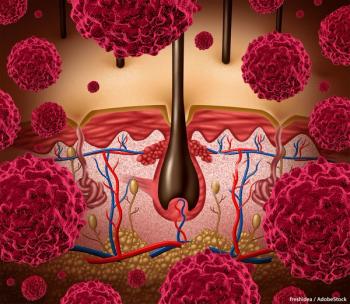
Targeted Intervention Decreased Melanoma Risk, Increased Early Prevention
A new study found that a targeted screening and education strategy aimed at patients at high-risk for melanoma favorably affected behaviors that may reduce melanoma risk compared with a standard information-based campaign.
A targeted screening and education strategy aimed at patients at high-risk for melanoma favorably affected behaviors that may reduce melanoma risk compared with a standard information-based campaign, according to the results of a recent study
General practitioner counseling, combined with a skin examination and a self-assessment tool resulted in patients retaining information about melanoma risk factors, and reducing high-risk behaviors.
“Patients’ perception of their own risk may be a decisive factor in changing their behavior,” wrote researchers, led by Cédric Rat, MD, from the Département de médecine générale, Faculté de médecine, Nantes, France. “Giving patients personalized information about whether or not they are at elevated risk for melanomas could affect their perception of the risk.”
Rat and colleagues performed a pilot, clustered trial comparing two educational methods at 20 private surgeries in Western France. Ten general practitioners were instructed to identify patients at elevated risk for melanoma using the Self-Assessment Melanoma Risk Score (SAMScore), conduct a skin examination, and counsel them using information leaflets. The remaining 10 general practitioners displayed a poster and leaflets in their waiting room and examined patients’ skin at their own discretion.
The SAMScore questionnaire asked patients to identify their skin type (ie, very fair skin, dark skin, olive skin, brown skin, etc), if they have freckles, their approximate number of moles, if they experienced a blistering sunburn in their youth, if they have a previous diagnosis of melanoma or have a first degree relative with a diagnosis of melanoma, and if they have lived in a country with high sunshine.
After 5 months, the researchers assessed sunbathing and skin self-examinations among 173 patients using a questionnaire.
“Our study suggests that a multifaceted general practitioner–mediated intervention-that is, identifying patients at risk, performing skin examinations, and giving advice and printed information on prevention-had a greater impact on patients than a conventional information-based campaign in terms of changing behaviors in ways that may decrease melanoma risk and increase early detection,” the researchers wrote.
Patients given the intervention were more likely to remember the campaign compared with control patients (81.4% vs 50%; P = .0001). Intervention patients were also more likely to identify their elevated risk for melanoma (71.1% vs 42.1%; P = .001).
Looking at prevention behaviors, intervention patients were less likely to sunbathe in the summer (24.7% vs 40.8%; P = .048), and were more likely to conduct skin self-examinations (52.6% vs 36.8%; P = .029) compared with control patients.
“Our general practitioner–mediated intervention appeared generally safe and acceptable to patients,” the researchers wrote. “It is noteworthy, however, that the intervention patients tended to be more likely to worry about developing melanoma and to consult their practitioner again to discuss the disease.”
Newsletter
Stay up to date on recent advances in the multidisciplinary approach to cancer.



















































































